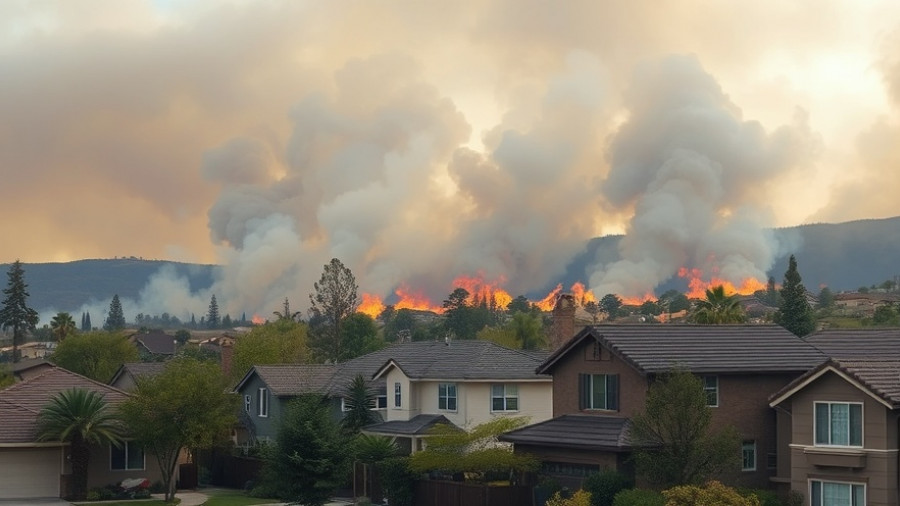
Understanding Fire Damage: What It Means for Homeowners
After a devastating fire, the road to selling your home may seem daunting. The visceral damage, physical and emotional, often leaves homeowners feeling overwhelmed. Understanding the ramifications of fire damage is crucial. Many potential buyers approach homes with fire histories with caution, fearing hidden issues lurking beneath the surface. The key is to navigate this complex landscape of disclosure, repair, and negotiation to ensure a successful sale.
Taking Post-Fire Action: Your Immediate Responsibilities
Once the smoke has cleared, your immediate actions are pivotal. Contacting your insurance company should be among your first steps, as filing a claim early can help cover restoration costs. Additionally, resources like the Red Cross and local disaster relief organizations can provide crucial support, whether it's temporary housing or cleanup assistance. Keeping a detailed record of damages and repairs is vital, especially if you plan to sell soon. This includes photographs, invoices, and any restoration contracts to demonstrate the steps you've taken to mitigate the effects of the fire.
Option 1: Make Repairs to Maximize Your Home's Value
Making necessary repairs to your home before selling can significantly boost your sale price. While this option requires upfront financial investment and considerable commitment, it can pay off in the long run:
- Higher Sale Price: Homes that are restored to their original condition can command prices closer to market value prior to the fire.
- Broader Buyer Pool: A repaired house attracts traditional buyers who are often hesitant to engage with properties that show signs of fire damage.
- Peace of Mind: Knowing your home is safe and fully restored can provide leeway in negotiations.
However, homeowners must weigh the benefits against the costs. Repairs can range from around $3,000 to $51,000, as reported in 2025 data from Angi, depending on the severity of the damage.
Option 2: Sell As-Is and Understand the Trade-Offs
If repairs are beyond reach, selling your home as is might be an appealing option. This approach allows for a quicker sale but generally at a lower price. Key considerations include:
- No Repair Costs: By selling as-is, you avoid the stress and expense of repairs.
- Fast Sales Timeline: This option can expedite the selling process, especially if time-sensitive personal circumstances necessitate a quick sale.
- Investor Appeal: Investors often seek out properties needing TLC, recognizing the potential for profit.
This strategy works best when fire damage is cosmetic, and the potential seller has little equity in the home or is confident in a forthcoming insurance payout.
Option 3: Selling the Land Only
Another alternative is to sell the land itself, particularly if the structure has sustained extensive damage. This option involves:
- Streamlined Transactions: Selling just the land often leads to a quicker and cleaner transaction.
- Clear Pricing Models: The value is primarily based on location and available land use.
However, it's essential to be aware of teardown costs and limited buyer interest, particularly if the land is in a less desirable area for new construction.
Documentation and Disclosure: Building Trust with Buyers
Whichever option you choose, documenting all repairs and improvements is fundamental. Buyers will want transparency regarding the property’s history. Keeping meticulous records, including receipts and photographs from the restoration process, can build buyer confidence and allow for a smoother negotiation process.
Additionally, legally speaking, you must disclose any fire history to prospective buyers, outlining specific repairs and the conditions that led to the fire. Fully disclosing details promotes trust and helps instill buyer assurance.
Emotional Considerations: The Human Side of Selling
The emotional fallout from a house fire can be profound. While financial considerations are critical, addressing the emotional toll is equally important. Acknowledging the trauma of losing a home can help facilitate a healing process that extends beyond the sale. Seek support from friends or professionals if necessary. The act of selling your home after such an event can serve as both a closure and a new beginning.
Final Thoughts: Navigate Your Options Wisely
In conclusion, homeowners faced with the aftermath of a fire have viable paths toward selling their properties. Whether through repairs, selling as-is, or parting with the land, clarity and diligence are essential. Each decision should align with your financial situation, emotional readiness, and timeline for selling. As the real estate landscape evolves, being informed and prepared will enhance your chances of maximizing your sale.
 Add Row
Add Row  Add
Add 



Write A Comment